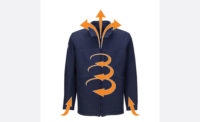FR clothing thread binds strength & performance

The transition from rolls of FR fabrics to cut pieces having various sizes and shapes to the assembly of a finished FR protective garment requires an understanding about structural integrity. Essentially, this means answering the question: How well do the cut pieces that are joined together with FR sewing thread compare to the strength and performance of the FR fabric being used to make the garment, before the fabric was cut?
The functions performed by this technically-engineered strand of yarn start with the production processes used to manufacture a garment. Later, yarn functions factor into the service life of the garment.
This article identifies and explains:
- What sewing thread is
- Comparison of FR sewing thread types and performance characteristics
- The interdependence of fabrics and sewing thread
- How seam selection and stitch selection are important
Sewing thread
The cost of the sewing thread used to build an FR garment represents approximately one percent of the price the end use buyer pays. This means a garment that costs $65 is assembled with approximately 65 cents worth of sewing thread; a garment structure that costs $1,000 is assembled with approximately ten dollars of sewing thread.
Sewing thread is a technically-engineered strand of yarn that is expected to perform these five functions:
- Consistently pass through the eye of a needle moving at a speed greater than 60 miles per hour;
- Penetrate multiple layers of fabric;
- Form a loop when it reaches the lowest point so that another sewing thread can interlock with it;
- Deliver the maximum strength possible;
- Maintain appearance and performance after multiple washings.
Continuous filament yarn, the original form of synthetic fibers, is the strongest and smoothest product. These types of yarns have a number of textile applications, but the use of continuous filament sewing threads in protective clothing is limited. Sewing threads that perform the best in the manufacturing of garments are made from either a TYPE I or TYPE II spun yarn.
Continuous filament yarns can be changed into TYPE I spun yarns by cutting the continuous filament into two-inch lengths.
This short staple length enables an inherently FR fiber to be spun into yarn with the same technology used to make cotton yarns.
Continuous filament yarns can also be changed into TYPE II spun yarns that have variegated length long staple (VLLS) from four to nine inches.
The method of spinning VLLS yarns is similar to that used for modified worsted wool.
Meta-aramid sewing threads
Garment manufacturers have been searching for options to address the end use customers’ demands for new levels of FR clothing durability. Meta-aramid sewing threads are recognized as the best choice for making FR protective clothing because they have a wide color range, good wash performance and good chemical resistance, in addition to being inherently flame-resistant.
It’s well known that virtually all of today’s FR clothing manufactured to meet industrial workplace hazards of open flame, flash fire, petroleum fire, molten metal splash, and electric arc are made from blends of different fibers. The fabrics combine various percentages of inherently flame-resistant fibers, which have characteristics that protect the wearer from external dangers. Meta -aramid sewing fibers don’t support combustion when exposed to flame and will self-extinguish when the flame source is removed.
Other FR fibers are used to address human comfort. Innovations for human comfort have resulted in a variety of fabrics that demonstrate tensile break-strength characteristics more like the poly-cotton fabrics used for non-FR work clothing.
Types of sewn seam failure
- Seam break
A seam break is the failure of the sewing thread along the stitch line. This failure indicates that the sewing thread contributes to a sewn seam efficiency approximately equal to a ratio from 80-85 percent of fabric break strength. This type failure also means that a garment can be repaired.
- Fabric rupture
This failure indicates the sewn seam construction is stronger than the fabric break strength. When this occurs the garment must be replaced because it cannot be repaired.
Washing & durability
A wash study was coordinated by a third-party certifier of protective clothing to learn how the “critical” seam junctions of FR garments are affected after multiple laboratory washings and dryings.
All of the multi-fiber blend FR fabrics used in the study had a fabric weight, weave construction, and break strength that could be used to manufacture the same type of FR garments. Seams were constructed using both Spun Meta-Aramid, TYPE I and VLLS Spun Meta-Aramid, TYPE II sewing threads. Fabric break strength measurements were taken as received new, and again after 25, 50, 75, and 100 washings. Various seam constructions were to be tested for seam strength as received new, and also tested again after 25, 50, 75, and 100 washings.
After-wash results
All of the fabrics showed a consistent performance in break strength after 25, 50, 75 and 100 washings. After 100 washings the fabrics showed a nominal loss that varied from six to nine percent of the original break strength.
Washed sewn samples
The study also demonstrated that after 25 and 50 washings thresholds a significant number of the sewn samples made with the multi-fiber blend fabrics demonstrated various modes of construction failure along the stitch lines.
Although sewing thread represents approximately one percent of the price paid for an FR protective garment, the wrong choice can have unexpected and unintended consequences.
Conversely, selecting the best performance for this small amount can mean both long-term service and added value for the users of FR protective clothing.
This article is an excerpt of a technical paper that was presented at the ASTM F23 Symposium on Protective Clothing in January, 2016. A copy of the complete technical paper (D01: 10.1520/STP159320160087) may be obtained from ASTM, www.astm.org.
Looking for a reprint of this article?
From high-res PDFs to custom plaques, order your copy today!





